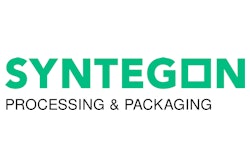Welcome to Package This — your guide to packaging machinery and materials, produced by the Emerging Brands Alliance in conjunction with Packaging World and PMMI, the Association for Packaging and Processing Technologies.
In this episode, we’ll look at feeding and inserting equipment. This group of machines covers a wide range of functions and might be best summed up as the equipment that gets products, components and containers staged and ready to complete the package on the packaging line.
These systems often work in concert with other packaging equipment, especially during a filling operation. First, let’s delve into a major technology used in today’s packaging lines: pick-and-place systems.
Pick-and-place machines are advanced robots that automatically load products into packages. Traditionally, many applications required workers to hand pick and place fragile items into packages. The image of workers manually picking, wrapping and placing cooled chocolates into heart-shaped boxes might come to mind.
In the late 1990s, robot manufacturers introduced automated systems that outperform humans in terms of speed and accuracy while maintaining the delicate handling required. Today, these pick-and-place systems, featuring delta robots and cutting-edge machine vision technology, enhance efficiency, accuracy, and consistency while reducing labor costs for brands.
Let’s look at the RPP robotic pick-and-place system from Syntegon. Here, we see it picking flow-wrapped packs from an infeed conveyor and stacking them onto another conveyor. As items move through the infeed conveyor, the RPP’s lighting and vision system detects the exact position of the items.
Up to three delta robots work together to gently pick and precisely place items without damaging the product. Syntegon’s turnkey, automated product handling solutions can place items flat or on-edge. And they are engineered to be flexible and scalable, offering maximum configuration and format flexibility for fast and reliable changeover. This unit is also designed with a compact footprint to fit on the plant floor.
Placement and feeder systems are our next group. Feeder technology varies widely, from desiccant feeders that insert bags into bottles to eliminate moisture, to literature feeders that insert instruction manuals or promotional material into various packages.
One common type of machine in this group is the friction feeder, used to separate and feed individual sheets or items from a stack. They are used to precisely feed labels, leaflets, and other flat items into or onto a range of package styles at high speeds. One example is a feeder that consistently centers a round, ingredient label on top of a frozen pizza before it is wrapped.
MFT Automation specializes in feeding equipment including friction feeders. Here we see MFT’s ip3 friction feeders running stacks of printed inserts for packages. These machines come standard with batch count software and a system to guarantee the correct count, made possible by MFT’s proprietary Double Detect Sensor. This technology is also available on the company’s HCP series of friction feeders. MFT’s friction feeders integrate seamlessly with other machinery in the plant, including labelers, conveyors, discharges, printers, and other equipment.
Now, we turn to a specialized type of equipment used in bottle filling lines: orienting and unscrambling. Orienting and unscrambling machines take empty containers and sometimes products and correctly and consistently orient or organize them prior to filling.
Here we see a plastic bottle unscrambler that prepares containers for a liquid filling line. Empty plastic bottles to be filled are dumped into a hopper haphazardly and must be organized. This is where the unscrambler comes in, rotating and aligning the bottles systematically to ensure the mouth end faces upward. It also places them uniformly in line onto the conveyor for streamlined and efficient filling.
Vibratory feeders are another type of machinery within the feeding and inserting group.
These machines are designed to orient and place small or lightweight products such as screws into a package. There are many types of feeders that get products were they need to go by shaking. Here, we see a circular vibratory feeder that gently shakes and rotates screws inside a bowl before moving them onto a narrow track, where they are counted and fed into a package, single-file.
Protective packaging feeders are specialty feeders designed to help prepare packages for shipment. These machines feed paper-based or plastic protective packaging or other materials into the headspace of a package before sealing for shipment.
Here, we see air-filled plastic cushioning being inflated before it is fed into a shipping container or box and cut just prior to sealing. Such air cushions prevent delicate products, such as electronics, from being damaged during shipment.
Another type of feeding and inserting equipment is referred to as hanger applicators. This type of machine is most often seen applying the hanger or hang tab on to consumer packages for retail display.
As the retail package to be displayed is conveyed through the system, pre-punched adhesive-backed hang tabs are separated from a sheet and applied consistently to the same part of the package so that it will hang neatly on retail store shelves.
Getting products and containers in the right place on a packaging line so they can be fed, filled, and completed is where the family of machines called feeding and inserting equipment comes in.
We hope you enjoyed the video and learned a little about this type of packaging technology. If you did, please like and share it with your network.
For more videos on packaging machinery and materials, please subscribe to our full Package This series on YouTube. And for a deeper dive into the technology we discussed here, explore PMMI ProSource, a searchable directory with 1,000 packaging and processing suppliers. Visit ProSource.org to search suppliers by package type, material, or features. Thanks for watching!


























